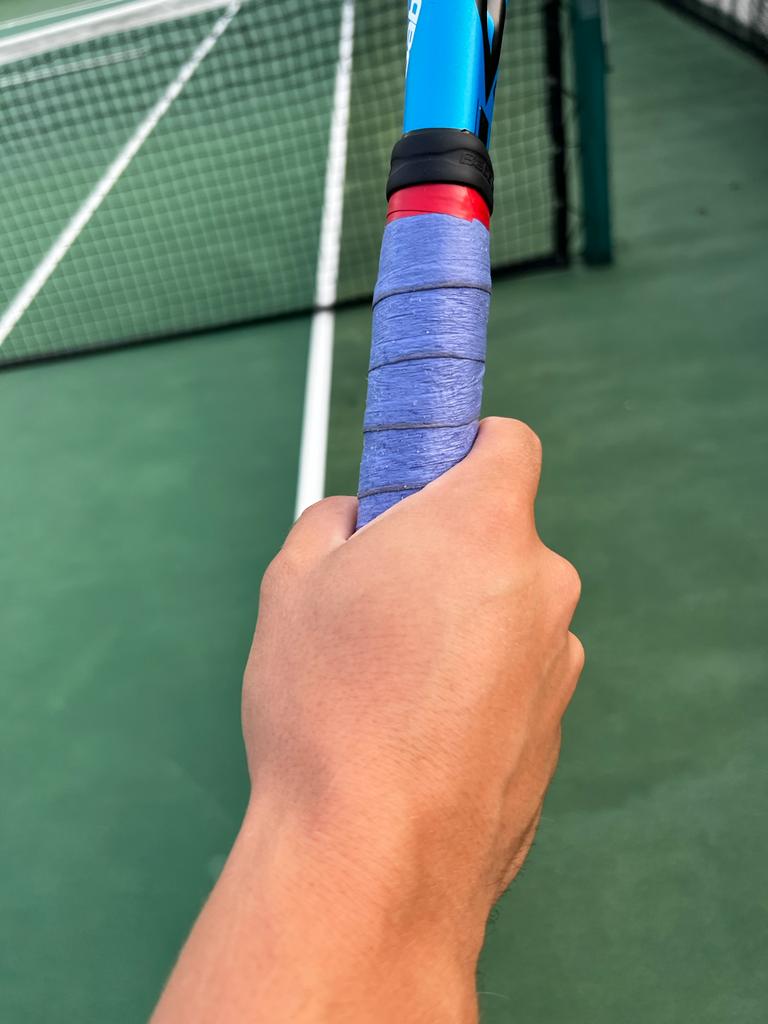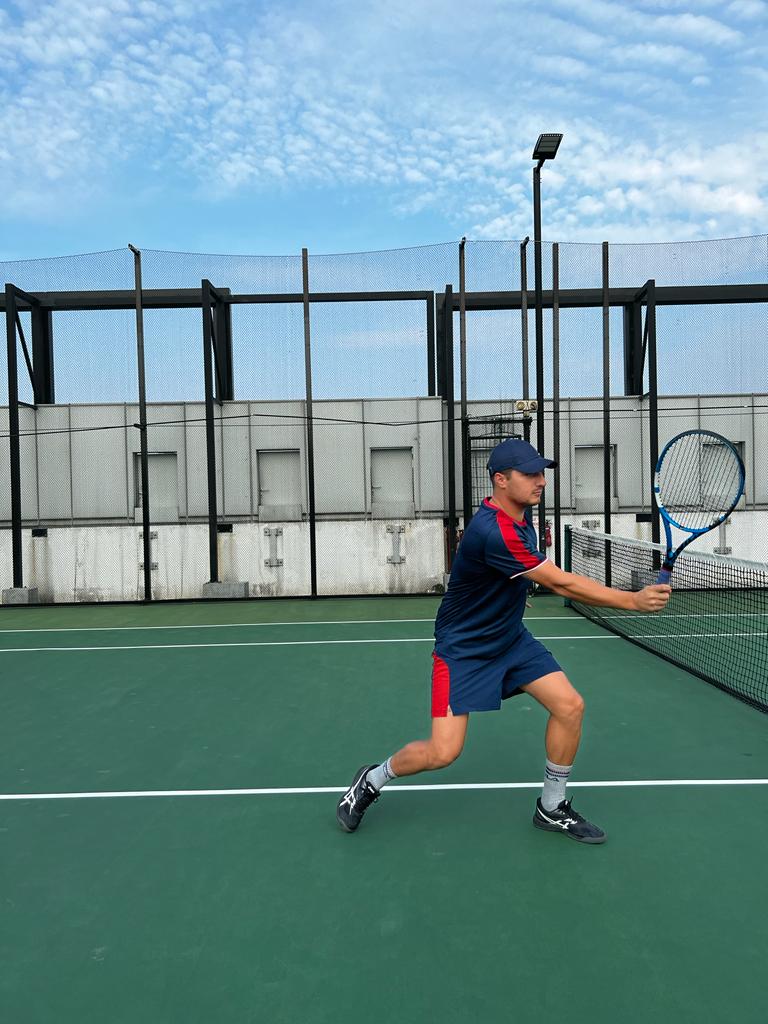The Volley
The volley is a shot where you can really use the expression ”less is more”!
No swinging of the racket is necessary for this shot. Instead, the player delivers a short and firm punch of the racket head to the ball before it bounces on their side of the net. A slight underspin is applied, and it is optimal for the ball to be higher than the net.
The closer you are to the net the more the volley can be angled away from your opponent. If you play the volley from further back in the court then it needs to be deep – unless you are making a drop-volley.
The grip to use is always a central grip with the wrist on top – Continental style with fingers spread for control. A firm wrist and short punching movement of the racket head.


An essential part of volleying is shoulder turn and a forward step with your leading leg. If time allows for this preparation. Sometimes you must improvise, be content to get your racket face on the ball and just get it back over the net.


Forehand volley
The forehand volley is ideal with a Continental grip and fingers spread for control and feel. This grip facilitates easy transition to a backhand volley with minimal or no grip change in emergency situations.
To play the forehand volley turn your body sideways and take your racket back no further than your playing shoulder. The contact point of the racket to the ball needs to be in front of your leading leg.
Step in with your left foot and transfer your weight from the back foot to the front foot as you punch the racket head through the ball. Keep your wrist firm and continue with your stroke in the direction of the ball’s flight.
The downward punch imparts underspin to the ball, providing additional shot control. The underspin makes the ball bounce low upon reaching the court surface on your opponent’s side of the net.
Improving your shot
Your shot will improve by concentrating on three main factors – racket takeback, hitting zone and racket head.
The takeback of the racket is mainly achieved by the turn of the shoulders – everything after the shoulder turn is then forwards, in front and to the side of your body.
The hitting zone is level with or in front of your leading hip. Additionally. it depends on how much preparation time you have for the shot. Squeeze your grip for maximum racket head control and follow the ball’s forward flight.
The outcome of your shot relies on how the racket head contacts the ball, which in turn depends on a strong wrist and firm grip.
Hold the racket at approximately 90 degrees to your arm, ensuring that the racket head is positioned above the wrist. The wrist is then at its strongest and most stable position.
A useful practice drill is to stand with your back to the stop netting and prepare to turn sideways and play a forehand volley. Hitting the stop netting during the racket takeback indicates insufficient contact point in front of your body.
You may have to play a high volley, low volley or angled volley in the course of a tennis match. They all require the basic volley technique with minor adaptations to suit the shot.
High volley
Turn to the right early and give yourself time to take the racket a little further back still keeping a firm wrist. Punch downwards, through the ball and continue the stroke in the shot direction.
Low volley
Turn to the right and bend your knees getting down really low and close to the ball height. Step in with your left leg and punch under the ball to give lift and underpin. Follow upwards with your racket in the direction of the ball lift.
Angled volley
The closer you are to the net the greater the angle of volley possible – simple geometry!
Short takeback with shoulder turn only. Punch well in front of your body and aim to take the ball. As early as possible to get maximum height and angle of your racket face. Follow through crosscourt in the ball direction.
A useful practice drill is for two players to face each other across the net and around the service line on each side. One player hits down-the-line volleys the other plays crosscourt volleys – count how many shots before an error occurs.
Gaining the net position for a good volleyer is always a useful strategy it enables you to pressure your opponent and put him at a disadvantage. You can volley the ball as far out of reach as possible.
Forehand drive volley
Typically, playing a very aggressive shot from mid-court aims to win the point and avoid being left in a vulnerable court position.
A particular favourite shot of Serena Williams that she played to perfection. The shot is a cross between the forehand drive and the forehand volley – embodying a little technique from each.
The player hits the shot before the ball bounces on the volleyer’s side of the net. They use a shorter take-back than a groundstroke. The player strikes the ball in the air with added topspin, targeting waist to shoulder height.
The shot is an important part of the women’s game – you will see less drive volleys played by the pro men.
Improving your shot
Your shot will improve by concentrating on two factors – the looped take-back and the upward swing of the racket imparting topspin to the ball.
When you notice a floating or mis-hit ball coming over the net, ideal for a drive volley, you need to react quickly. The sooner you can get to the ball the better your chance of making a winning drive volley.
Play the shot deep cross-court or deep down the line – no compromise – go for a winner!
Have your practice partner or coach feed floating balls mid-court for you to hit and practice the forehand drive volley. You start around the baseline and move quickly in to play one shot down the line and one shot cross-court.
Forehand and backhand stop and drop volleys
Both stop and drop volleys require ”soft” hands and are essentially touch strokes that will drop the ball just over the net out of reach of your opponent.
The crucial distinction between them is that the stop volley is executed off a fast ball, while the drop volley is used for a slow ball.
When playing the stop volley, the player withdraws the racket slightly upon impact to absorb the speed of the ball. The racket’s face moves under the ball, applying a significant amount of spin. It is not an easy shot to execute.
In the drop volley, the racket doesn’t withdraw on impact but follows the ball forward, moving under it to provide spin and control.
Achieving success with these shots relies on the critical angle of the racket face to the ball. If the racket face is too open, the ball will go high over the net and become easily reachable by the opponent. Too closed a racket face and the ball will land in the net.
Backhand volley
The backhand volley is easier to play than the forehand volley because the arm and racket, when you have turned your body sideways, are already well forward and clear of your body.
The Continental grip is again, like the forehand volley, the best option to use as it gives you greater versatility.
As with most shots, early preparation gives the best chance of success. Turn your body sideways and take the racket back level with your left shoulder – step forward and punch the ball with a firm wrist well in front of your body.
Follow through with your racket a short distance in the direction of the shot.
Improving your shot
Your shot will improve by concentrating on the same three factors as with the forehand namely – take-back, hitting zone and racket head.
The follow-through of the backhand is easier to play than the forehand as you don’t have to cross over your body.
High backhand volley
Playing a high backhand volley helps to use your non-playing hand to steady the racket at the throat and limit its take-back. Make sure you don’t drop your racket head in the follow-through and drag the ball downwards into the net.
Backhand drive volley
This shot is played much easier if you use a two-handed stroke and the same principles as the forehand shot apply – take care with the take-back, hitting zone and racket head.
